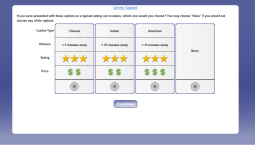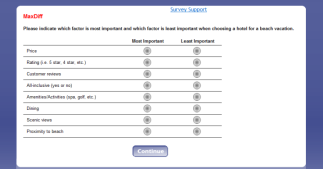Intercept Survey Solutions has extensive experience delivering advanced research methodologies. We not only have the technical capability, but we understand the research objectives of using each methodology. Intercept will act as a consultant to you to make sure the right technology and techniques are used to meet your objectives. Here are a few examples of our most popular research techniques.
Conjoints/Discrete Choice
 Intercept Survey Solutions has programmed a variety of different conjoint and discrete choice exercises. Whether you require a simple choice-based, a chip allocation, or follow-up questions, we have the experience to deliver. We can work with any materials you deliver, but we typically receive an Excel file with the cards describing the attributes and levels, and a rotation schedule indicating the cards for each task. Intercept strives to present the tasks in the most appealing manner possible so that your respondents do not get bored after a few iterations. We can identically match any example you present. In addition to custom programming of conjoints, we can also host Sawtooth web design files, if provided.
Intercept Survey Solutions has programmed a variety of different conjoint and discrete choice exercises. Whether you require a simple choice-based, a chip allocation, or follow-up questions, we have the experience to deliver. We can work with any materials you deliver, but we typically receive an Excel file with the cards describing the attributes and levels, and a rotation schedule indicating the cards for each task. Intercept strives to present the tasks in the most appealing manner possible so that your respondents do not get bored after a few iterations. We can identically match any example you present. In addition to custom programming of conjoints, we can also host Sawtooth web design files, if provided.View Demo
MaxDiff Exercise
 Max/Diff exercises have become very popular in the last few years. Respondents are shown a series of statements and asked to rate the favorite and least favorite. Intercept Survey Solutions has a lot of experience with these studies. Similar to discrete choice exercises, we typically receive an Excel file indicating the rotation of the tasks but we can also do a simple randomization, balanced by quota group, if necessary.
Max/Diff exercises have become very popular in the last few years. Respondents are shown a series of statements and asked to rate the favorite and least favorite. Intercept Survey Solutions has a lot of experience with these studies. Similar to discrete choice exercises, we typically receive an Excel file indicating the rotation of the tasks but we can also do a simple randomization, balanced by quota group, if necessary.
Segmentation Algorithm
Segmentation algorithms are a method to categorizing respondents based on their attitudes and behaviors. We are typically presented with an Excel file (often refered to as a "Typing Tool") that provides the calculation for each segment. Our clients often receive these from a client, vendor, or other department and do not have knowledge of it themselves. With our strong research background, we are able to dissect it without aid of instruction. A Quality Control manager will also program the algorithm in his data validation specs so that we can be 100% certain the algorithm is accurate when we do our data test prior to launch.
Advanced Quota Logic
Quota logic is one of the top sources for programming errors and mishaps because most programmers do not understand research. At Intercept Survey Solutions, we are all experienced research professionals so we understand your goals and can recommend the right approach. We have a variety of tools available to meet your objectives:
- Fully-Nested: We can fully-nest multiple criterions to achieve an equal balance, obtaining a distinct count in each group. We've used this approach effecitvely for up to 1000 quotas, but it is most often used to achieve a census representation within gender, age, income, region, etc.
- Percentage-Based: We can also use percentages to define the boundaries of your sample, but not force a distinct count in any particular group. For instance, we can ensure a concept assignment meets the census breaks for age and income but does not force age and income to be nested.
- Random/Augment: We understand the objectives of random (representative) and augment (over-quota) quotas and can field both concurrently without impacting the integrity of the representative sample.
- Least-Filled: We regularly use a "least-filled" approach to balance your sample and/or assign the lowest-incidence group, maximizing the value of your sample.
